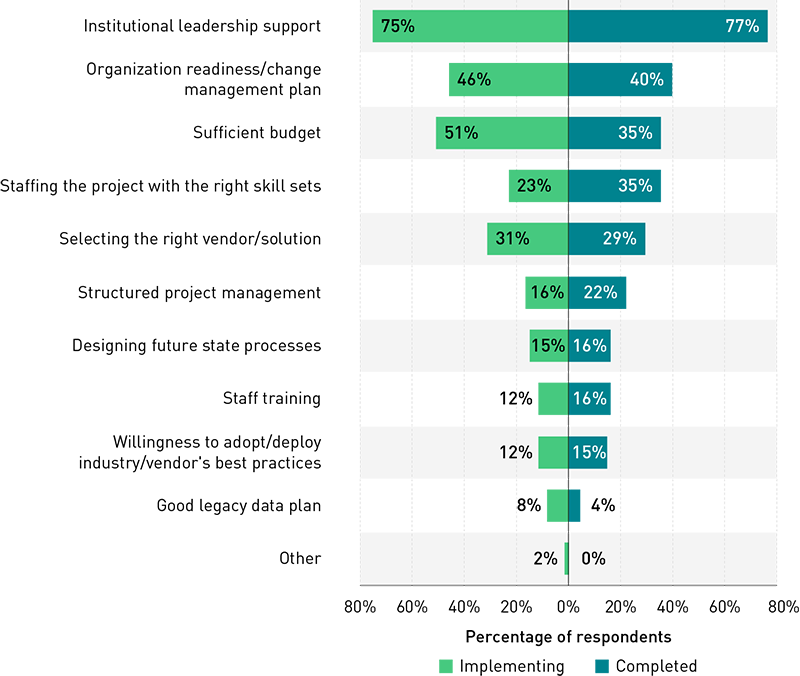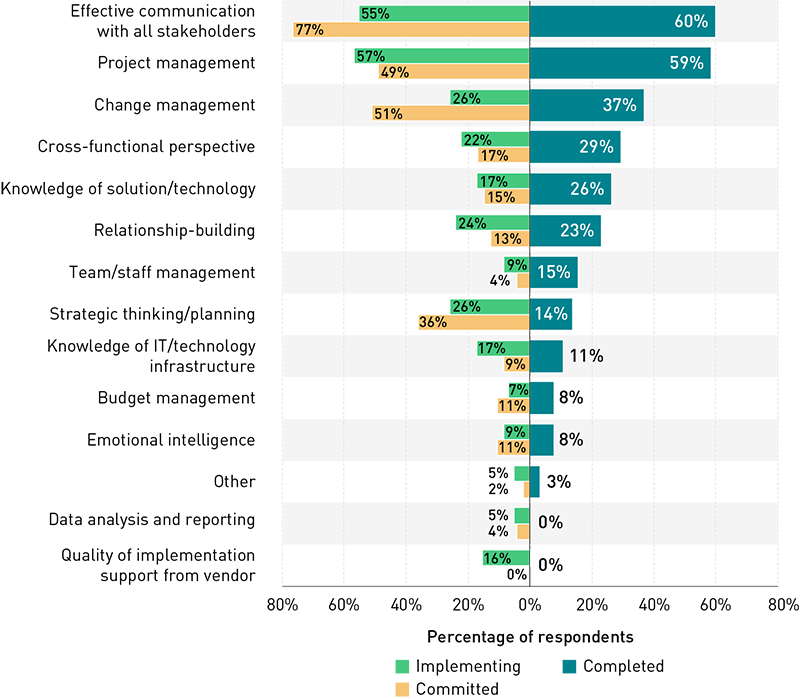Institutional Culture and Readiness for Change
Institutional culture—specifically, openness to change and wide-scale coordinated projects—can have a significant impact on an ERP implementation's success. Proactively addressing culture issues before, during, and after an ERP implementation is essential to ensuring the new system is embraced and adopted by leadership, faculty, staff, and students. The most critical success factor reported by respondents, by a significant margin, is institutional leadership support. This support must start at the top, encompass the entire senior leadership team, and be sustained throughout the implementation and beyond.
People, not technology, require the most attention before, during, and after implementation. The data from both the survey and interviews made one thing abundantly clear: while software helps drive change and guide processes, a focus on people—leadership, users, managers, and others—is critical for successful implementations. This theme continues to show up at every stage of ERP implementation and is a key component of many of the critical factors reported by respondents (see figure 8) and important professional skills (see figure 9) needed for successful ERP implementations. (Because they were so much earlier in the implementation process, interested and committed respondents were not asked all questions in the survey.)


An ERP implementation is not an IT-only project. An ERP implementation involves a range of stakeholders, including IT staff, business users, senior leadership, and operational staff. While IT staff provide essential support during system selection, installation, and configuration, daily users need to be involved in the planning, selection, and implementation process to ensure the system meets their needs. They can serve as voices of support for the project, helping ensure institution-wide buy-in and commitment to the changes that will be required.
Interviewees shed additional light on why an ERP implementation should be viewed as more than an IT project:
- ERP systems affect all aspects of a business, not just IT.
- ERP implementations require a significant change in business processes.
- Changes in business processes can be highly disruptive to operations.
- High-level commitment from leadership helps bring the message of importance to all end users.
- A strong communication plan and transparency of progress updates builds trust, commitment, and reasons to celebrate success.
Involving stakeholders from across the institution can be a challenge, and some ERP project leaders may not know where to start or how to involve them. Interviewees offered advice on how to effectively engage stakeholders outside IT or the project team:
- Start with a clear business case for end users. How does an ERP system align with institutional mission and goals? What are the expected benefits in efficiencies, end-user experience, reporting, and analytics?
- Develop a detailed implementation plan that can be easily shared with stakeholders. This should include a timeline, budget, and list of tasks.
- Plan to send out regular communications to all stakeholders. Keep everyone updated at regular intervals on the project's progress and address any questions or concerns that may come up.
- Help stakeholders prepare for change. ERP implementations are disruptive, so it's important to help others understand the changes that will occur related to their business processes and work.
- Training is essential for all users. Greater familiarity with the new system and a basic understanding of its functionality can help assuage concerns and questions that may arise as business processes change.
Hiring or selecting an internal change management representative is key. With all of the complexities and disruptions an ERP implementation can involve, it is important to have a change management representative who can help identify business processes, facilitate regular and clear communications within and across teams and departments, and keep track of stakeholder training and project goals to ensure the implementation is successful. This is a challenging role for anyone. Interviewees identified several skills and competencies institutions should look for when selecting a change management representative for an ERP implementation. A change management leader should:
- Have a deep understanding of the organization's culture and processes. Before implementing an ERP system, it is essential to understand the institution's culture, including its values, beliefs, and practices. Understanding the culture can help identify potential challenges and opportunities that may arise during the implementation process.
- Be able to build relationships with stakeholders. Involving stakeholders from across the organization—including faculty, staff, students, and administrators—in the planning, design, and implementation processes can create a sense of ownership and buy-in for the new system.
- Communicate the need for change. Clear communication is critical during an ERP implementation because it keeps everyone apprised of the changes that are occurring and why they're occurring. Effective communications are sent on a regular basis and should be designed to address the audience's questions, concerns, and needs.
- Manage resistance to change. Emphasizing the benefits of the new system—including improved efficiency, increased transparency, and better data management—can help buoy morale and overcome resistance or skepticism.
- Consistently and accurately measure and report on project success. Interviewees reported greater institutional support when they provided updates on implementation progress and milestones. This should also include keeping track of and managing training for employees, as well as any go-live launches for departments or business units.
- Create a culture of continuous improvement. Implementing an ERP system is not a one-time event; it requires ongoing maintenance and improvement. It is essential to foster a culture of continuous improvement—including regular feedback and evaluation processes, ongoing training and support, and a willingness to adapt and change as needed—to ensure the new system continues meeting the institution's evolving needs.
For institutions whose leaders are considering or starting to implement a new ERP system, all interviewees recommended hiring an external change management representative or selecting an internal team member to serve in a change management capacity to ensure the project's success.
How Palm Beach State College Created a Business Process Map to Guide Implementation
Conducted the necessary—and considerable—work to create a business process map. IT worked with every business unit and walked through the current business processes and then asked, "If nothing was a hindrance to changing this process, how would you make it better? What would be the best way?"
"Listen to the product users; they have some of the best insights into how to improve their processes."
Brought in an implementation partner to help guide the process. Implementation partners bring great insights and can help guide processes. These partners understand higher education culture and needs and especially how they fit with specific ERP solution capabilities.
"We brought in an implementation partner who was aware of our business processes and culture. This made it easier for them to help us integrate the new systems and processes through each stage of the process."
Understood that moving to a cloud-based solution meant following standard business processes. The products and processes that come with a cloud-based solution mean you must deal with their infrastructure. The vendors, especially for HR and finance, are following best practices of the public and private industries, so organizations need to adapt to their standard business processes.